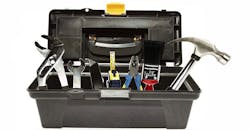Go into the tool section of a typical hardware store, and you’ll find a range of prices for what initially seem like the same tools. One socket set costs $20 more than another one with the same sizes of sockets. Why is that? And why do two screwdrivers the same size vary so much in price?
Take a closer look at the tools. It costs more to make professional grade tools than it does to make consumer grade tools. In addition to such typical upgrades as better quality steel and better finishes, professional grade tools often have features that make the work safer and more accurate. To identify these features, compare the tools with consumer grade versions and/or consult the manufacturer’s literature.
Consumer brands are fine for casual use, but not for daily work. Your first layer of defense is to identify the consumer brands and stay away from them. Then identify the professional brands and select from those.
About the Author

Mark Lamendola
Mark is an expert in maintenance management, having racked up an impressive track record during his time working in the field. He also has extensive knowledge of, and practical expertise with, the National Electrical Code (NEC). Through his consulting business, he provides articles and training materials on electrical topics, specializing in making difficult subjects easy to understand and focusing on the practical aspects of electrical work.
Prior to starting his own business, Mark served as the Technical Editor on EC&M for six years, worked three years in nuclear maintenance, six years as a contract project engineer/project manager, three years as a systems engineer, and three years in plant maintenance management.
Mark earned an AAS degree from Rock Valley College, a BSEET from Columbia Pacific University, and an MBA from Lake Erie College. He’s also completed several related certifications over the years and even was formerly licensed as a Master Electrician. He is a Senior Member of the IEEE and past Chairman of the Kansas City Chapters of both the IEEE and the IEEE Computer Society. Mark also served as the program director for, a board member of, and webmaster of, the Midwest Chapter of the 7x24 Exchange. He has also held memberships with the following organizations: NETA, NFPA, International Association of Webmasters, and Institute of Certified Professional Managers.
